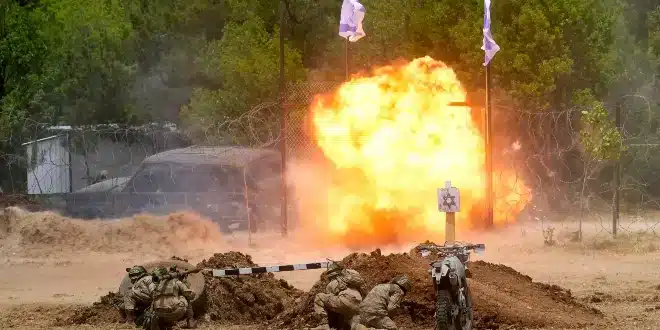Officials and analysts report that thousands of fighters from Iran-backed groups across the Middle East are prepared to join Hezbollah in Lebanon if the current conflict with Israel escalates into a full-scale war.
Since the onset of the Gaza war in early October, triggered by Hamas’s attack on southern Israel, there have been nearly daily exchanges of fire along the Lebanon-Israel border. The situation intensified after an Israeli airstrike killed a senior Hezbollah commander in southern Lebanon, prompting Hezbollah to launch hundreds of rockets and explosive drones into northern Israel.
Israeli officials have warned of a potential military offensive in Lebanon if a negotiated resolution is not reached to distance Hezbollah from the border.
Over the last decade, Iran-backed fighters from Lebanon, Iraq, Afghanistan, and Pakistan have fought together in Syria’s civil war, tipping the balance in favor of President Bashar Assad. Officials from these groups indicate they could reunite against Israel if needed.
Hezbollah leader Sayyed Hassan Nasrallah stated that militant leaders from various countries have offered to send tens of thousands of fighters to support Hezbollah, although he mentioned that the group already has over 100,000 fighters. Nasrallah hinted that the current conflict only utilizes a fraction of Hezbollah’s manpower, primarily those specializing in missile and drone operations.
Officials from Lebanon and Iraq backed by Iran suggest that fighters from across the region are ready to join the battle if a full-scale war erupts on the Lebanon-Israel border. Thousands of such fighters are already stationed in Syria and could easily cross the border into Lebanon.
Since the beginning of the Israel-Hamas conflict on October 7, some of these groups have already launched attacks on Israel and its allies, employing a “unity of arenas strategy” and stating they will continue until Israel halts its Gaza offensive against Hamas.
An anonymous official from an Iran-backed group in Iraq confirmed that their fighters are ready to support Hezbollah if a comprehensive war breaks out. He also mentioned that some Iraqi advisors are currently in Lebanon.
Another official from a Lebanese Iran-backed group said that fighters from Iraq’s Popular Mobilization Forces, Afghanistan’s Fatimiyoun, Pakistan’s Zeinabiyoun, and Yemen’s Houthis could potentially join the conflict in Lebanon.
Hezbollah expert Qassim Qassir noted that the current fighting relies heavily on high-tech warfare, such as missile launches, which doesn’t require a large number of fighters. However, he acknowledged that prolonged conflict might necessitate external support for Hezbollah.
Israel is aware of the potential for foreign fighters to join the conflict. Eran Etzion, a former Israeli Foreign Affairs official, indicated a high likelihood of a “multi-front war” involving groups from various countries.
Since Hezbollah began its attacks on October 8, it has launched over 5,000 rockets, anti-tank missiles, and drones toward Israel, according to Israeli military spokesman Daniel Hagari. Hagari warned that Hezbollah’s increasing aggression could lead to a broader conflict with severe consequences for Lebanon and the region.
Hezbollah officials maintain that they do not seek an all-out war but are prepared for it if it occurs. Deputy leader Sheikh Naim Kassem stated that any expansion of the conflict would be met with a strong response to deter further Israeli actions.
The U.N. has also expressed concern about the risk of the conflict escalating into a wider war, with potential for miscalculation leading to a sudden and broader conflict.
The last major conflict between Israel and Hezbollah was in 2006, resulting in significant casualties on both sides. Since the current clashes began, over 400 people have been killed in Lebanon, mostly fighters, but also including 70 civilians. On the Israeli side, 16 soldiers and 11 civilians have been killed, with tens of thousands displaced on both sides.
Qassir noted that the prior experience of fighting together in Syria could aid the coordinated efforts of the “axis of resistance” if foreign fighters join the conflict, emphasizing their shared military strategy and coordination.


